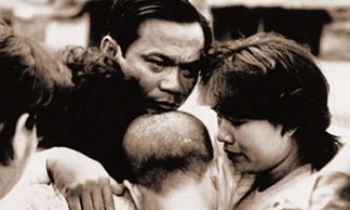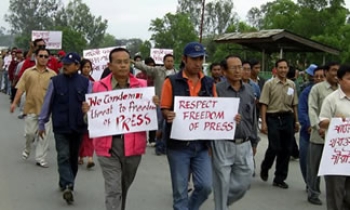NEW YORK: Five new-media leaders explained how their news staffs have sprinted from the technology dark ages to the forefront of innovative journalism -- and how others must follow suit or be relegated to the history books -- at a Columbia University panel discussion Wednesday night titled "The Changing Media Landscape, 2005."
The discussion brought together Len Apcar, NYTimes.com editor; Jeff Gralnick, NBC special consultant and former VP of ABCNews.com; Andrea Panciera, editor of The Providence (R.I.) Journal's ProJo.com; Craig Newmark, founder and chief customer service representative (explanation below) of Craigslist; and James Taranto, editor and columnist for the Wall Street Journal's online editorial page, OpinionJournal.com.
As the panelists spoke and fielded questions, moderator Sree Sreenivasan, Columbia Journalism School's dean of students, pulled up relevant Web sites on a screen behind the speakers, introducing at least a few to giant versions of Wikipedia, Instapundit, and Buzzmachine.
At one point, Panciera turned questions back on the audience, asking about their rates of media use. Her first question, about how many people read newspapers in print form, backfired slightly when almost every hand went up.
"This is a skewed response," she laughed. "At most colleges I go to, almost no one is reading a print newspaper," she said. After continuing through her list of media -- cell phone updates, text messaging, online videos, instant messaging -- Panciera explained how this line of questioning could help news outlets stay relevant.
"Look at your own behavior and see how that can transfer into the [journalism] industry," she said, noting especially that information is no longer received in discrete forms, but on ever more integrated platforms.
Although panelists' responses took a potentially explosive turn when Taranto lit into The New York Times editorial page for it's stance on Judy Miller, the evening wrapped up like a how-to course in new media, complete with juicy buzz words and sound bites, which we've collected below.
For Apcar, who transferred to NYTimes.com after the 1999/2000 dot-com bust, the Internet is now enjoying as big a boom as ever mainly because broadband access is now a fixture in many American homes.
"That made the internet this surgical strike information source," he said, which in turn made it most people's first choice for information.
- Reader control: We recently have seen a paradigm shift away from the old model -- in which journalists chose and ranked news and delivered it to readers, who took it just as it came -- to one where the reader decides what information he or she wants, when, from where, and how it looks with advances such as RSS (really simple syndication) programs.
- Interaction: Readers can "play reporter," they are encouraged to contact reporters, they can talk to other readers in chat sessions and on message boards. All of this is "building a sense of community around journalism," Apcar said.
- Acquisition: The New York Times recently bought About.com, has bid on several other sites, and will probably buy more soon, regardless of whether they directly have anything to do with journalism.
- Uncertainty: "We're not quite sure where this is going," Apcar freely admitted, pointing out that Bill Gates, while visiting the Times newsroom recently, said exactly the same thing of the Internet. Gates told Apcar, for instance, that he thinks Internet searching will be vastly different in another 10 years. For one thing, searches are hampered greatly by their inability to pinpoint a computer user at a physical, geographical location. The challenge remains to "stay abreast" of such continuous change.
- "Pay walls": After a long debate over charging for online information, The Times introduced TimesSelect in September, asking readers to pay for online access to its columnists, archives, and other services. The decision came only after lengthy research where readers' responses indicated they would pay for The Times' "branded" columnists as well as other functions, if offered. Although he declined to give specific numbers, Apcar said he was pleasantly surprised by high retention rates past the 14-day free trial.
Newmark said he hates being called "Craigslist founder" because in his mind almost all his time is dedicated to customer service. Likewise, he seemed a little unsure how he had ended up in the midst of so many journalists. "We somehow have affected the news industry," he admitted, sounding apologetic that Craigslist had indirectly caused investigative reporters to be laid off. "We need a lot of people digging into stuff," Newmark said, making his own sarcastic digs about the "press' vigilance" helping us avoid any "vanity wars" lately.
- Disinformation: Like Craigslist, online publishers must develop detailed strategies to deal with purposefully propagated false information that spreads like wildfire across online forums.
- Decentralization: Professional and amateur journalism will merge increasingly, so get used to information coming from individuals you don't expect. Newmark held up community-edited, online encyclopedia Wikipedia as an example of the trend against the old adage that "winners write the history."
In her 11 years as editor of the Providence Journal's online content, Panciera has finally seen the paper's relatively vast print resources genuinely integrated with her small online staff of about 12. "Convergence" came up repeatedly in her comments -- of print and Internet, of multiple media and platforms, of reporting and personal service.
- Chat: By setting up a chat on ProJo.com for female, high school tennis players, the paper was able to give readers what they wanted (interaction) and to gain insight into this audience (by reading over the chat topics).
- Convenience: Panciera found that readers don't always go to the "best" source for information. They often go to what is easiest, or cheapest, or simply whatever works. Thus the journalist's overall mission remains the same, "To gather and deliver news and information people really need to live their lives," but that must be presented in an environment of varied media, access and approach.
- Registration: "We have to explain to [readers] better what value they are getting from us to get them to cross that registration wall," Panciera explained. Another way to draw them in is to focus on what they want specifically online. For instance, classified ads, movie listings, or a specific article about a family member from 10 years ago.
"I admit to being a dinosaur," Jeff Gralnick began. Or at least he was before he took up the helm of ABCNews.com and became an Internet convert. When Princess Diana died in September 1997, receiving 5 million page views in a month opened the site's eyes to the readership possibility it presented. This September Gralnick cited 750 million page views, 250 million slide views and 26 million unique users. Hence his characterization of the Internet as a "baby on steroids."
- Hide and seek: News organizations have to go out and find their audiences now, "on whatever devices they are using," Gralnick insisted. Are newspapers dead? Maybe. But they definitely are if they can't adapt to this new reality.
- Personal devices: Call them what you will, but small, hand-held devices providing everything from phone to email to TV streaming are the next huge thing.
- Reporter blogs: Don't think of them as competition. Think of them as exposure, as a way to employ a voice that doesn't quite fit your publication, as a direct link to your audience. But think about them hard, Gralnick warns, or suffer the inevitable consequences.
At the other end of the spectrum from The Times' pay-to-view columns, The Wall Street Journal put the majority of it's online content behind a pay wall but introduced a free editorial site, OpinionJournal.com. James Taranto insisted they "try to put the best stuff online," and his "Best of the Web Today" blog has gained widespread popularity.
- Synthesis: "This column makes me much smarter than I would be myself," Taranto points out, as he receives information from hundreds of sources daily, which he then collects and analyses.
- Story driving: New media has changed history. Period. Trent Lott would still be Majority Leader, Dan Rather might still be reporting, and Harriet Miers would still be headed for the Supreme Court if their shortcomings hadn't become such instant household information through online dissemination. "My original story [on the lack of support for Miers] would never have been as prominent in print," Taranto said. Journalists and politicians alike take heed: "If you do something foolish, you're going to get jumped on very quickly."
The William Randolph Hearst Foundation endowed the panel, part of a new annual series that reflects the Columbia Journalism School's growing emphasis on new media.
Miki Johnson (letters@editorandpublisher.com) is a reporter at E&P.









